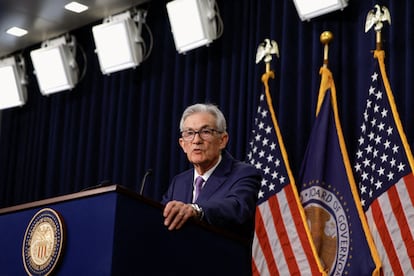Investors look to the Fed for clues about rate cuts
Market consensus continues to point to September as the most likely moment for the price of money to go down

Many investors are packing their bags for their summer break in the hope that no unforeseen events will interrupt their long-awaited rest. But before they close up shop, the meetings of the Federal Reserve, the Bank of Japan and the Bank of England will be closely scrutinized. Monetary policy decisions have become, along with artificial intelligence, the great drivers of the market.
The main focus will be on America’s central bank. Although in recent weeks former New York Fed President Bill Dudley has spoken out in favor of a rate cut, market consensus continues to point to September as the most likely moment for the price of money to go down. Fed funds futures (financial futures contracts based on the federal funds rate) give a 107% probability to this scenario. François Rimeu, a senior strategist for Credit Mutuel AM, believes that a reassuring inflation outlook and a labor market back in balance could open the door to a less restrictive monetary policy, but that more evidence of disinflation is still needed. This expert expects Fed Chairman Jerome Powell to lay the groundwork for future rate cuts in September. “We believe the Fed will communicate monetary easing more clearly at the next meeting in Jackson Hole at the end of August,” he stresses.
With unemployment above 4% for the first time since 2021, many investors believe that the Fed should have already lifted its foot off the accelerator and joined the trend initiated by the European Central Bank last June when it implemented the first cut in the price of money in eight years. However, the institution considers that the labor market is at its optimum point and that, although the upturn in inflation experienced at the beginning of the year was temporary, disinflation will be slower than expected in the coming months.
The main medium-term risk is the November presidential election. The withdrawal of Joe Biden from the presidential race and the possibility of Kamala Harris being nominated as the Democratic candidate at the convention to be held between August 19 and 22, has caused Donald Trump to lose support. However, there is still a risk that the Republican tycoon will return to the White House and put a sharp increase in import tariffs back on the table.
Raphael Olszyna-Marzys, an international economist at J. Safra Sarasin Sustainable AM, points out that a 10% tariff on imported goods as proposed by Trump would add 1.5% to prices for one year. In other words, it would increase price pressures and limit the Fed’s room to act. “Powell will avoid commenting on political developments,” Olszyna-Marzys remarks. Nevertheless, the expert is optimistic that the Fed will lower rates in the U.S. twice this year (September and December) and cut rates once per quarter in 2025.
The economy remains resilient, but the fear of recession has not been completely overcome. Giles Moëc, chief economist at AXA IM, recommends that to avoid having to embark on a rapid succession of rate cuts later and avoid a derailment, it would be advisable to start the process well in advance. “Powell can escape criticism if he telegraphs the cut in September clearly enough this week and makes it clear that it would only be the start of a series of cuts,” he notes. This would involve making it clear that the June dot plot has become obsolete. In the latest projections, the Committee downgraded the rate cut for this year from three to one.
The only discordant voice is Philip Orlando, chief equity strategist for Federated Hermes. “Historically, the Fed prefers to avoid making a change in monetary policy between Labor Day (May 1) and Election Day. Especially if the decision is close and it can afford the luxury of patience,” he notes. That is just the current scenario. In the second quarter, GDP defied all forecasts and grew by 2.8%, a far cry from the 1.4% at the start of the year. The expert points out that, if you combine the trend in the labor market and inflation with the toxic political environment, the Fed will cut rates after the election. “We expect a 0.25% cut at the Nov. 7 and Dec. 18 appointments,” he notes. Looking ahead to 2025, the expert expects a 1% cut for the year as a whole, which would bring the upper band of rates to 4%, down from 5.5% today.
Sign up for our weekly newsletter to get more English-language news coverage from EL PAÍS USA Edition
Tu suscripción se está usando en otro dispositivo
¿Quieres añadir otro usuario a tu suscripción?
Si continúas leyendo en este dispositivo, no se podrá leer en el otro.
FlechaTu suscripción se está usando en otro dispositivo y solo puedes acceder a EL PAÍS desde un dispositivo a la vez.
Si quieres compartir tu cuenta, cambia tu suscripción a la modalidad Premium, así podrás añadir otro usuario. Cada uno accederá con su propia cuenta de email, lo que os permitirá personalizar vuestra experiencia en EL PAÍS.
¿Tienes una suscripción de empresa? Accede aquí para contratar más cuentas.
En el caso de no saber quién está usando tu cuenta, te recomendamos cambiar tu contraseña aquí.
Si decides continuar compartiendo tu cuenta, este mensaje se mostrará en tu dispositivo y en el de la otra persona que está usando tu cuenta de forma indefinida, afectando a tu experiencia de lectura. Puedes consultar aquí los términos y condiciones de la suscripción digital.
More information
Archived In
Últimas noticias
Maduro pleads not guilty before the federal court in New York: ‘I am still the president of Venezuela’
A new test can detect Alzheimer’s from a finger prick
UN team enters Sudanese city of El Fasher after paramilitary massacre: ‘It’s like a ghost town’
A recipe for resistance: Indigenous peoples politicize their struggles from the kitchen
Most viewed
- Gilles Lipovetsky: ‘If you want to live better and fall in love, take Prozac, don’t look to philosophy’
- Alain Aspect, Nobel laureate in physics: ‘Einstein was so smart that he would have had to recognize quantum entanglement’
- Alvin Hellerstein, a 92-year-old judge appointed by Bill Clinton, to preside over Maduro’s trial in New York
- Why oil has been at the center of Venezuela-US conflicts for decades
- Maduro’s downfall puts China’s relationship with Venezuela to the test











































